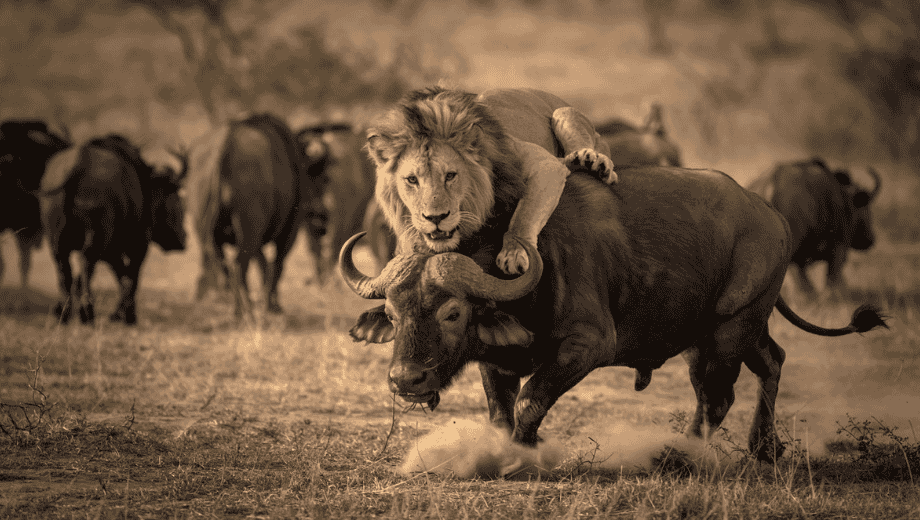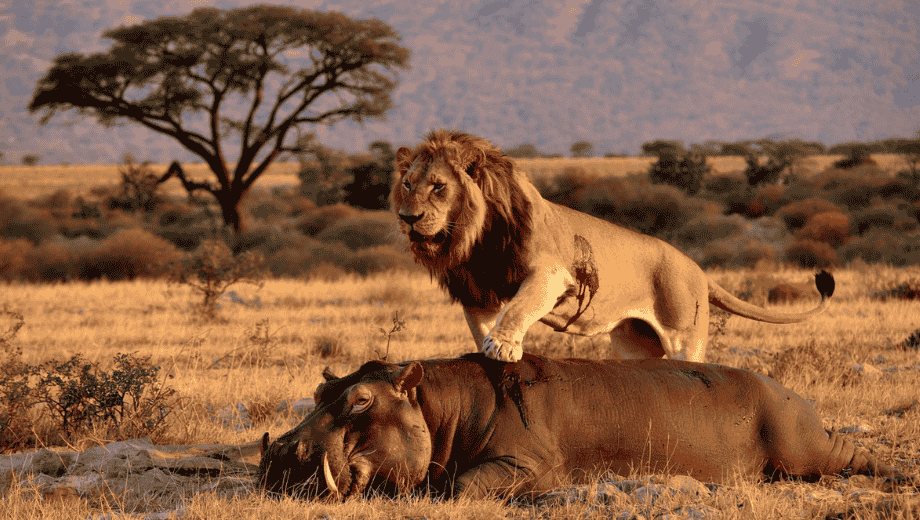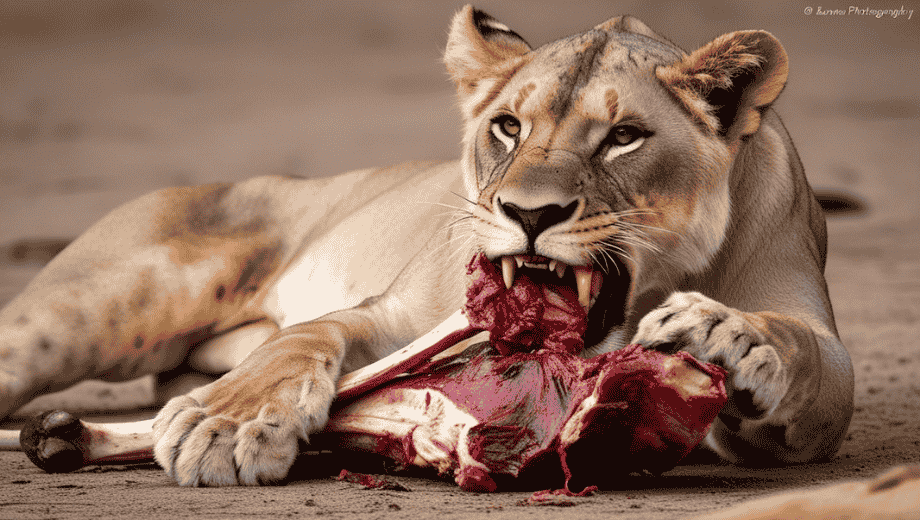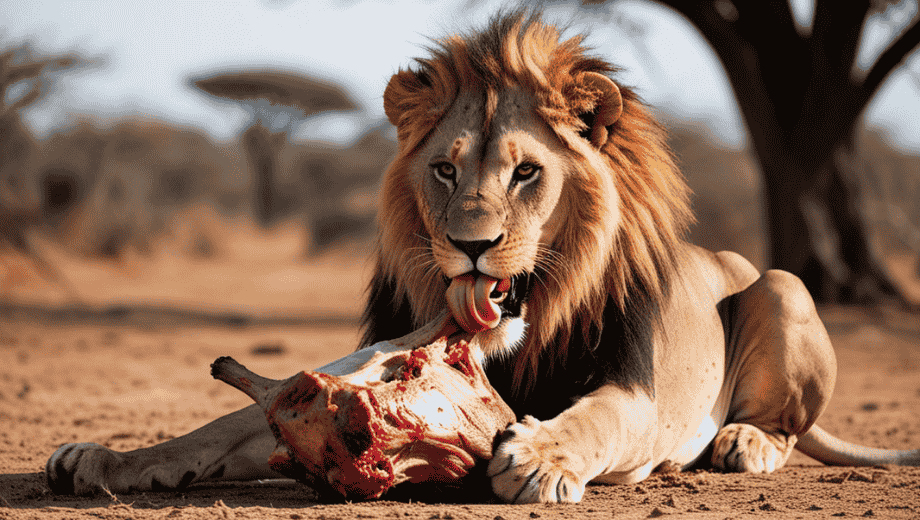What animals do Lions eat? Lions are carnivorous animals that consume meat as their primary source of food. Lions prey on animals from 45 to 453 kg (100 to 1,000 lb), with Buffalo being the most hunted animal. The lion, that untamed beast, that wild, sprawling beast, has always attracted the curiosity of humanity, the uncapturable element. Would you say so? Their hunting skills and feeding habits have a significant influence on their survival. This guide provides detailed information on what animals do Lions eat:
- The animals most frequently eaten by lions – this word should be in the plural.
- Quantity of food that needs lions per day (7kg for males, 4.5kg for females)
- Uncommon hunting methods of lions
- How hierarchy within the pride changes their feeding behaviour
- Changes in diet according to the climate
- Even if you’re not a fan of wildlife, this guide will explain all the whys and wherefores of lion hunting, food-acquiring habits, and so much more, just as if you were there.
Key Takeaways:
- Buffalo is a definite choice for lions, the quality predators that depend on large herbivores as their food source.
- For one meal, males need 7kg of meat, while females require 4.5kg.
- Teamwork is essential for lions when the question is about the convenience of the hunt, especially among lionesses.
- Successful hunting combines different environmental factors, the time of day, and the kind of animal being hunted.
- Leadership, rank, and the amount of food available play a role in determining their feeding patterns, especially when there is a food shortage.

Main Prey Animals
Large Herbivores
The African savanna furnishes lions with a daily supply of large herbivores that are their staple food in the region. These predators are designed to chase and bring down big animals to feed their pride. Almost all of their prey come from animals of medium to large size, usually from 100-1,000 pounds. It is observed that Buffalo, zebras, and wildebeest are the animals most often hunted. The meat from these large animals can accommodate everyone in the pride. The daily consumption of the male lion is approximately 7kg, whereas the female consumes about 4.5 kg.
Despite being dangerous and huge, Buffalo is exactly what lions love. Buffalo can be as heavy as 1,500 pounds, which makes them difficult yet satisfying prey. A successful hunt can last the pride for many days.
Smaller Prey Options
In the Prey Group, Although many lions prefer prey such as Buffalo, they will not disregard an opportunity for a great meal. Once big game gets out of reach, lions turn to smaller prey species like Thomson’s gazelles, warthogs and small antelopes. Lions tend to hunt smaller game individually and stealthily instead of in a team effort. Small prey yields minimal meat, so lions must take many kills quickly.
If periods or places of the year are arid and animals’ large prey has moved far away, lions predate small animals like birds or hares. Such small meals are time-consuming, dear, and less nourishing than the larger prey.
Key Takeaway:
Even though the primary food of lions consists of large herbivores such as Buffalo, zebras, wildebeests, etc., they sometimes will hunt smaller prey in certain situations. They complement each other by mostly being able to eat many different types of animals.

Hunting Techniques and Success Rates
Pride Hunting Strategies
The orchestrated hunt by the lions is by far a demonstration of the instinct and expertise in hunting. Lions use their notable instincts to catch animals, the presence of the main food of their prey, and their actions as a team. A significant difference is seen in their coordination level and sociability traits. The females of the group are the ones who are in charge of deciding which prey to focus on and are the ones usually shooting the hunt forward.
Factors Affecting Hunting Success
Naturally, the success of the hunts carried out by a lion or a group of lions is affected by various factors. During the day, they tend to succeed in the range of 17% to 19%, and an indication of their remarkable effectiveness is found in the figure of 30% at night. They do better during unlit and dense nights and when hunting in areas where the environment provides good cover.
When lions hunt alone for smaller prey, their success is less than when they prey on larger animals in a crew. The size of the prey determines their stance on the targeted animals.
Key Takeaway:
The hunting success of lions ranges from 17-30%, varying according to the time of day, place, and prey category in their diet. It is the flexibility to change that makes them such efficient hunters.

Geographical Variations in Diet
African Lions
They adjust their hunting methods according to the geographical conditions common to African lions. In the open areas, the main game for the lions are large herbivores like zebras, wildebeest, and antelope. Large prey are not fixed in one place, and thus, the lions follow the prey’s movements. However, lions feed on small animals in some dry areas without a big game.
Indian Lions
Being exclusive to India’s Gir Forest, this breed of lion is different in terms of the environment that has changed their natural lifestyles. They frequently hunt the spotted deer, sambar deer, and even the nilgai antelope of the place. The Indian lions are more adaptable to the diversified forest environment and have become smaller-medium game hunters, and when their natural prey is rare, they cheat occasionally and use livestock to feed themselves.
Key Takeaway:
It is the location where the lions live that influences their feeding habits. While African lions prey on big herbivores, those in India prefer smaller forest animals.
Conclusion
To know what animals do Lions eat. Finding out the prey of lions can help us understand more about the top performance of apex predators. From their advanced hunting skills to their food preferences, lions become vital to ecosystems’ normal operation. Catching and eating animals of different sizes and simultaneously forcing them with other members of the pack guarantees the continuation of this species in the wild. The performance of their success in hunting is a must for the good of their family and the environment in Africa. If you watch the spectacle of lions at close range, you will gain more respect for them and their dietary needs after reading this. By participating in conservation activities, we can ensure that these exceptional animals carry on the balancing act and safeguard the environment. This will be a wonderful experience.
FAQs
How often do lions have to eat to keep going?
Lions usually consume food every 3-4 days and can eat as much as 40 kg in just one meal. Lions can hold on for two weeks without food by living off body fat and smaller prey.
Do lions consume their cubs?
Male lions feed on the cubs in case they have acquired a new pride. This practice, known as infanticide, is essential because it makes the females return to the breeding state at a faster rate.
Are lions able to survive without needing to eat big game?
Although lions are predisposed to catching large prey, they can survive by hunting and eating small animals like hares, birds, and reptiles when the larger prey is absent.
Is the lion hunting primarily morn or eve?
The lion is predominantly nocturnal, which is the best time for hunting prey in the dark (most of the animals prefer hunting shortly before the sun sets and sunrise). Because they have better night vision, lions hunt more effectively at night.
What Animals Do Lions Eat?
In general, lions hunt their prey in terms of the accessibility of prey and the reigning of pride and vulnerability of prey. They are out of the park, preying less often on the weak, sick, or older animals for efficient hunting.
Are male lions involved in the hunting process?
The majority of hunting tasks belong to female lions yet male lions assist in capturing gigantic prey by employing their power and robust physique effectively.

